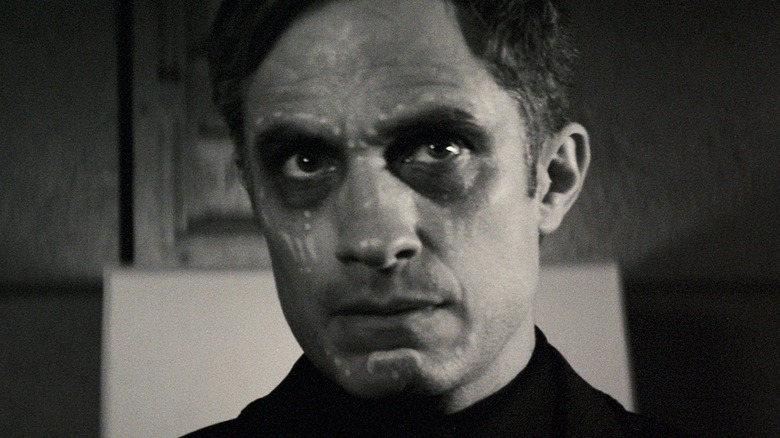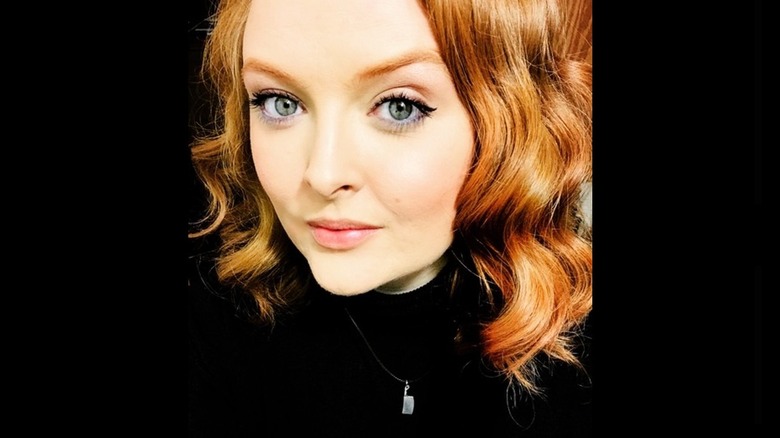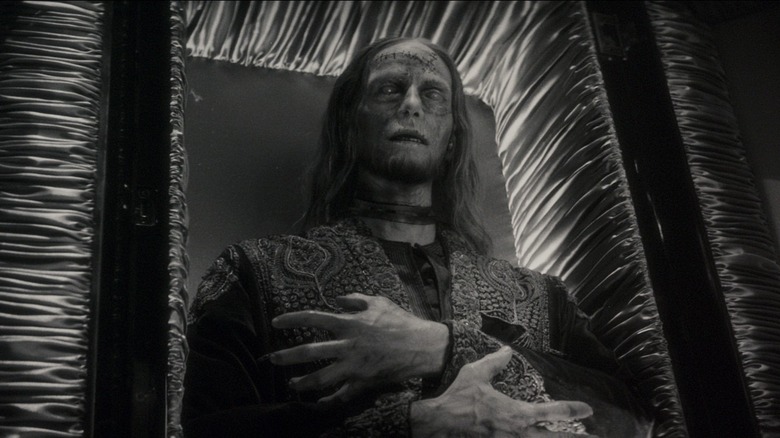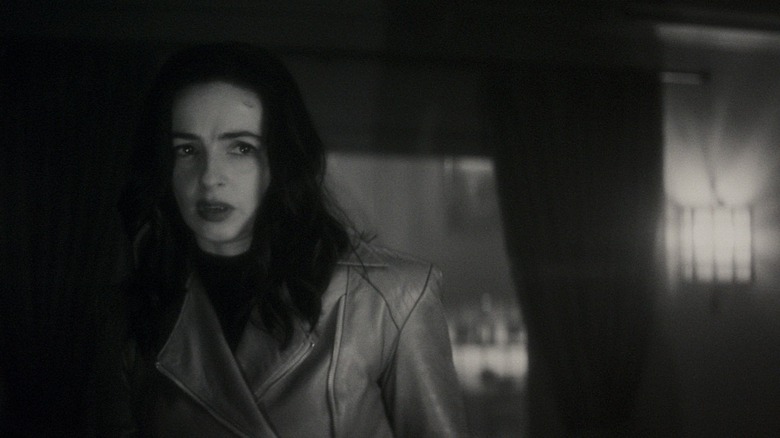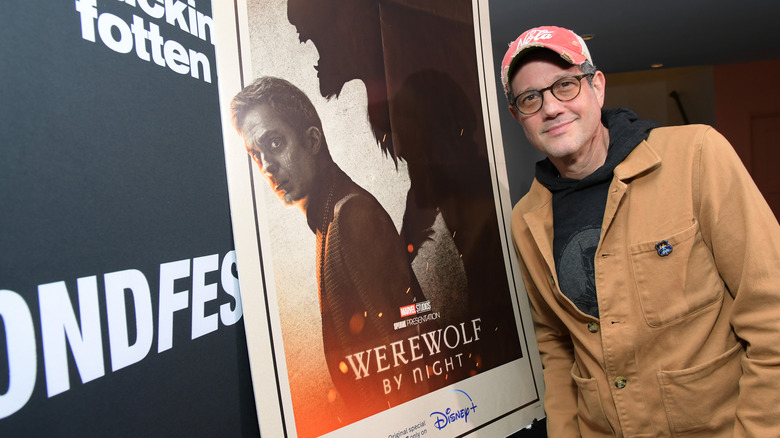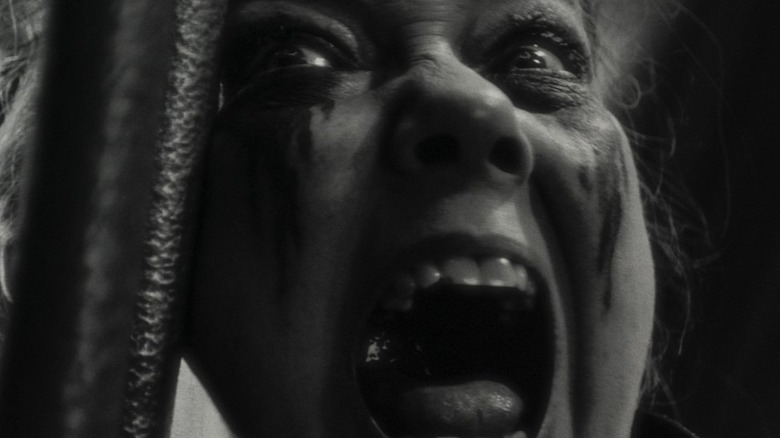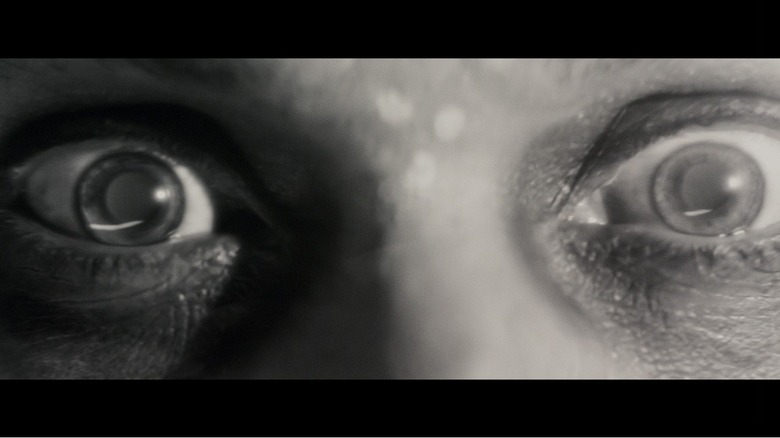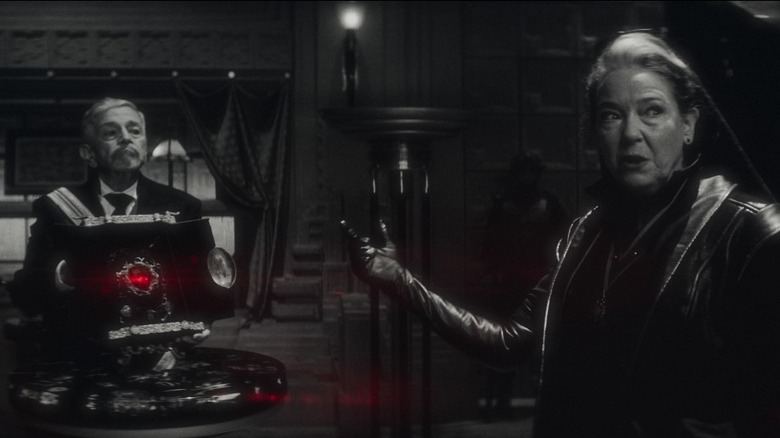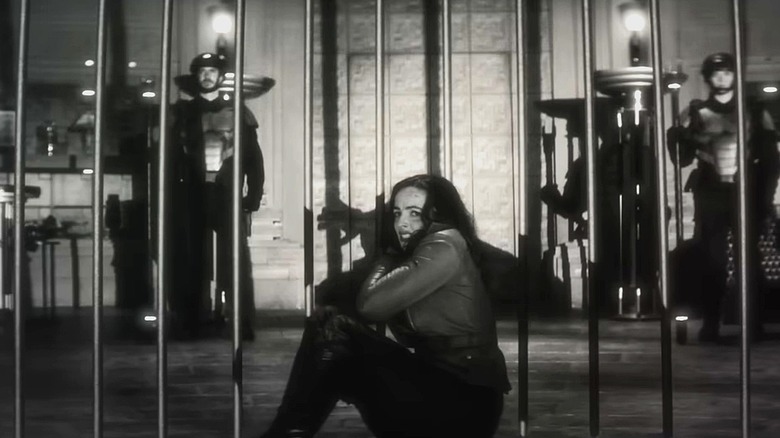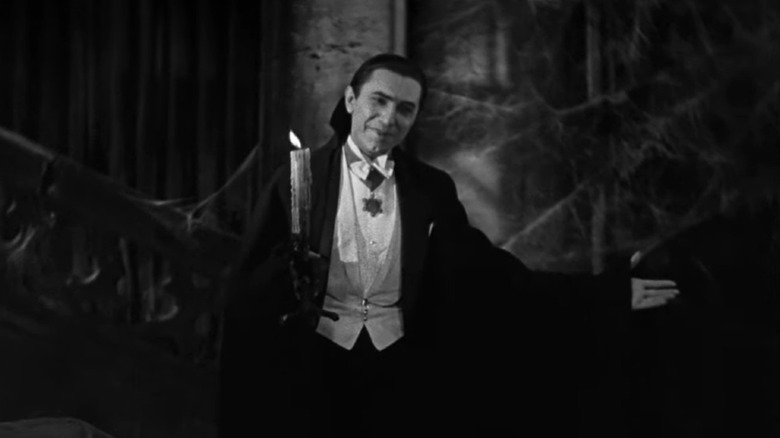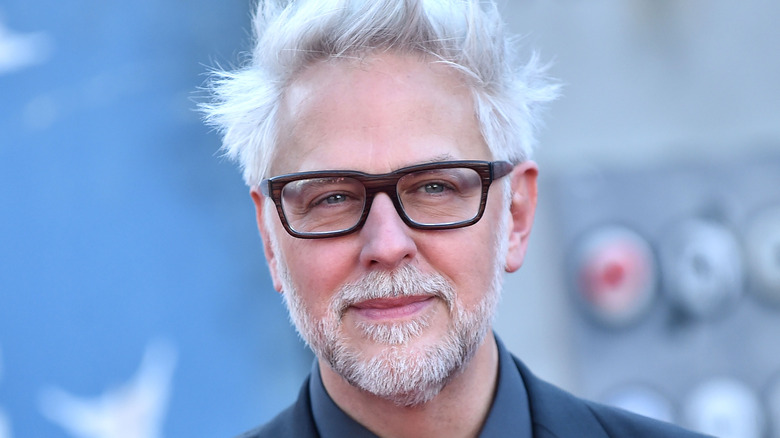Werewolf By Night Makeup Department Head Ellen Arden On Marvel Studios' Black-And-White Horror Venture - Exclusive Interview
As "Doctor Strange in the Multiverse of Madness" proved, Marvel Studios had no qualms about dipping into the horror genre by hiring the "Evil Dead" trilogy maestro Sam Raimi to bring his horror sensibilities into the MCU. Perhaps more exciting, though, is the affirmation by Marvel that its first venture into the horror genre was not a one-and-done experiment, as composer-turned-director Michael Giacchino's "Werewolf by Night" swings the door wide open to a whole new world of scary possibilities.
In the thick of "Werewolf by Night" is Ellen Arden, who serves as the head of the makeup department for the new Disney+ streaming special. Arden is no stranger to the makeup craft, having worked on more than 60 films and television series since her debut as a makeup artist in 2005. A lot of Arden's work has been for films in the Marvel Cinematic Universe, including "Black Panther," "Spider-Man: No Way Home," and the upcoming "Guardians of the Galaxy: Vol. 3," as well as the MCU series "Hawkeye." She's also done her share of horror projects, including the hit series "The Walking Dead" and Netflix's trilogy of "Fear Street" movies.
"Werewolf by Night" stars Gael García Bernal as Jack Russell, one in a small group of monster hunters who are scrambling to find a stone that has the power to control all monsters. The artifact, aptly named the "Bloodstone" after its original owner, Ulysses Bloodstone, is being offered up for the hunt because of Ulysses' passing. Among the hunters is Elsa Bloodstone (Laura Donnelly) — Ulysses' estranged daughter — who joins in the hunt against the wishes of her stepmother and father's widow, Verussa Bloodstone (Harriet Sansom Harris). The monster tale also features frightful characters who originated in the Marvel Comics, including the swamp monster Ted, aka Man-Thing (Carey Jones), and, naturally, the Werewolf by Night (Bernal), since Jack is cursed to become a lycanthrope.
In an exclusive interview with Looper, Arden talked about her work on "Werewolf by Night" — which marks Marvel's first foray into a black-and-white presentation — as well as how classic monster movies and other films from the golden age of Hollywood inspired her work on the special.
Jumping on a rare opportunity
What a wonderful departure for Marvel Studios with "Werewolf by Night." Even though you've already worked with Marvels Studios and done horror projects in the past, "Werewolf by Night" is on a whole different plane, isn't it? To do makeup work for a horror project that's in black and white and connected to Marvel, it doesn't happen. It's exceedingly rare.
It was definitely something that was in my wheelhouse. It was the perfect marriage of things for me because I've spent so much of my career on horror films, but then also, I have this whole superhero side of my career. It was great to marry those things, but it also had the interesting elements of black and white and being an homage to classic horror films. There were so many great components to it. It was definitely a dream come true for me to have such a cool project to work on.
The power of black-and-white films
I grew up watching black-and-white monster movie classics on TV on midnight shows like "Horror, Inc." When did these types of movies enter your life? Did you grow up with them, or did they pique your interest later on?
It happened very early because I grew up in the middle of nowhere. I'm from the middle of Michigan. We had "Midnight Madness" on TV. We didn't have cable — we had four channels.
At night, there would be these "Midnight Madness" or random movies. The other day, I was thinking that one of the movies that made a huge impact on me as a little kid was "Night of the Lepus," which I had to go back and revisit recently. It's crazy. It's about these giant killer rabbits. It's from the '70s. I was like, "God, this played such a huge part of my life." That was one of the first things I had nightmares about. But I do remember, too, watching a lot of black-and-white films. I always gravitated toward the classic Hollywood period. I loved "The Apartment," "The Seven Year Itch," all these movies that were classic Hollywood.
Billy Wilder was one of my favorite directors — he still is — and I naturally gravitated toward that on my own, and horror was a part of that. I loved "Dracula," "Dracula's Daughter," and all these Universal Monsters movies that were really cool to watch. I've carried those along with me to every project I've ever worked on, but specifically [for "Werewolf by Night"], it played a huge role because we had to look at things that were being translated in black and white, and also how to give it the updated Hollywood look.
Finding the right makeup for a black-and-white presentation
While "Werewolf by Night" is reminiscent of the monster movie stuff, it still has to forge its own unique identity. I would imagine that starts by you looking into what sort of makeup works in black and white. Was there any particular monster classic or even a Billy Wilder film that helped you create a template to replicate that classic look?
I definitely looked at "Dracula's Daughter" and a bit at this movie called "She-Wolf of London," because I knew that when we were approaching Elsa [Laura Donnelly], I wanted her to look different than everybody else. From the script and our meetings with Michael [Giacchino], we knew that she should be edgy and fresh, but at the same time, when she comes to this memorial and hunt to see everybody in garb, face paints, war paints, and all that kind of stuff, we wanted to set her apart.
Primarily for Laura, we focused on her classic beauty. Those movies really did play a hand in the makeup that we chose for her, because we needed her to be luminescent so that she had that whole old Hollywood makeup, 1930s lit-from-within type thing that you would see on those actresses from that day.
You have to admit, Laura Donnelly almost looks like she stepped out of a classic movie. Some actors work better in recreations of classic eras.
Laura's definitely one of those people. She's classically beautiful. I don't know why, exactly, but she's perfect the way she is.
Working to the rhythm of Giacchino's direction
How did Michael Giacchino differ from other directors you've worked with? You don't see it too often, where a composer leaps into the director's chair and does the score for the project as well. Do you think he brought his musical sensibilities in any way to the direction of "Werewolf by Night"? Was there a certain rhythm to what he did?
The great thing about working with Michael was that he was so excited about the show that it resonated with the rest of the crew. When you work on any show, there's so much that needs to be done. You can lose yourself in the chaos of everything. But it felt like he took time and made clear decisions with every component of the film, which felt very different because it wasn't like hand over fist making choices and throwing s*** together. It felt like we were making something and he was excited about it, so you couldn't help but be excited about it too. Therefore, you wanted to give him everything that he wanted and more.
Werewolf by Night could have been a color film, says Arden
Did you look to any modern black-and-white films for inspiration?
I didn't look at too many modern films because I'm a photo major. I went to college for photography and cinematography. When you go to school for fine art photography, you focus on something called the Zone System, and in that, there are basically these different tonal values of black and white. I had that in my pocket going forward, because I knew that we were working on a little bit of a different playing field than people in the '30s for panchromatic and incandescent lighting scenarios that they used then. But I focused on things that we actually knew would translate well.
We knew that the film could potentially be in black and white or potentially in color. We had to marry those two things and choose colors that were bright and visually striking in color, but also would play well if it was turned black and white — keeping in mind there were a set of scenarios that could happen in post, too, like contrast and all that stuff. We veered toward colors that were more middle gray. For example, Verussa, with her red makeup — her ritual makeup that you see when she's removing her cloak and her mask — is a primary red, because I know, and if you have some basic knowledge of black and white photography, that color's going to translate to a middle gray or medium gray.
Are you saying that you didn't know for sure "Werewolf at Night" was going to be black and white when you started? Some of the film is in color, but when you went into production, was the idea to make a black-and-white film or a color film?
We were shooting with the idea that it could go black and white, but at the same time, we could end up in color.
So it really was a matter of, "Let's do a scene, look at dailies and see how it works." When was that final decision made?
When we had gotten to the reshoots, we were positive that it was going to be released in black and white. We did some reshoots a little bit after principal photography. But Michael [Giacchino] has spoken in articles about Marvel and their hesitancy to actually release the film initially in black and white. They needed some [coaxing].
He knew that he wanted to release it in black and white — it looked cool. When we were on set looking at these monitors, it looked great. But it's not something that they actually do. We don't see black-and-white movies very often. Marvel has such great films that are pop-y and full of life and color. It was probably scary to [think of a film in black and white]; that these new characters would be introduced, and here they are in black and white.
Turning Jack into a werewolf
As the head of the makeup department, do you oversee everything? In addition to Laura Donnelly, did you get to work on Gael García Bernal's makeup for Jack as well as Jack's werewolf look?
Gael was with us in the regular makeup department as Jack. His Day of the Dead look [to honor Jack's heritage] was definitely us. Once he became the werewolf, the creature manufacturing was handled by KNB [EFX Group]. Carey Jones was the makeup supervisor there, and he also played Man-Thing. He was a jack of all trades on that show. Carey and a gentleman named Jeff Himmel handled all the werewolf appliances, including a full-body suit and a full set of appliances.
The makeup that we had to do for Jack before he was werewolf was also translated over into that. We did have a little bit of interaction with the werewolf makeup team once we knew what the design was for his Day of the Dead makeup.
Bloody parameters
Maybe you didn't have any involvement in this on "Werewolf by Night," but you certainly have experienced working with fake blood in the past with the "Fear Street" movies and "The Walking Dead." For example, when Jack bites the ear off of a certain character and we see the blood spurting, how different is the color of the fake blood when you're filming in black and white?
KNB uses blood specifically that is made by them. We also had blood scenes with Liorn, who is played by Leonardo Nam ... If there was any type of effect that was done by KNB or if it was makeup like blood that was hitting Jack, the werewolf, Man-Thing, or anything else, that blood specifically was manufactured by KNB. They had color schemes that they would've presented to Michael [Giacchino] before we actually shot anything. We do the same thing, but we were using Pigs Might Fly [a brand of washable, fake] blood from Nick Dudman.
Generally, we veer toward bloods that are dark. There's this whole thing about the color of blood and the ratings because blood can affect ratings, whether it be PG-13 or TV-MA. There's blood ratings in different markets. There's a lot of thought and decisions that revolve around blood. For "Werewolf by Night," [which is rated TV-14], the bloods were dark. They read better in black and white being dark anyway. The opacity and viscosity are important factors to look at when you're looking at bloods that need to read well in black and white, in color, and look real at the same time.
In living color
I follow Universal Monsters-themed pages on Facebook, and it's fascinating when color photos are posted of black-and-white productions where you can see what the makeup for Frankenstein's monster actually looked like and it's not what you imagined. Did you look at those sorts of old color photos from black-and-white productions to guide you in any way?
Yeah. There were some monster makeup tricks in the '30s that we did keep in our pocket in case. It has a lot to do with filtration. Because we were shooting for something that we knew could be in color, there's not an incredible difference in filtration for what we normally would be shooting in color. Sometimes if you're shooting something in black and white, you would put the filtration on it in advance, but it's going to turn all of your footage red or blue.
There are some great videos online that you can watch of makeup tricks that they did in the '30s ... It would all be done in-camera and through filtration. A lot of those would be like, if you had the red filter on and all this red makeup on, that makeup's not going to show. But as soon as you slide that blue filter on, it's going to pull all of that red and instantly appear. I can't remember what movie that is, but there are all these little tricks that people did that revolved around panchromatic film, incandescent lighting, and filtration.
As a makeup head, part of your process has to involve that cross-collaboration between the lighting and the cinematographer, especially since "Werewolf by Night" is so much about shadows and light. Part of what I loved about the old black-and-white monster movies was the use of the shadow technique to heighten the tension of a scene.
Right. You have to have an open dialogue with your director of photography. Michael [Giacchino] was so enveloped by classic monster movies that he knew exactly what he was looking for all the time. He also was so excited about the project that it made us want to do ... We pitched all these crazy things and had a lot of tests. Fortunately, because we were able to prepare, we were able to show up with our A-game and play into multiple scenarios.
Learning from the greats
In addition to looking at Billy Wilder's films and different horror films in preparation for "Werewolf by Night," did you also look at the work of the makeup greats like Jack Pierce or Bud Westmore or Milicent Patrick, who designed the Creature from the Black Lagoon?
When I first came into our industry, I mentored under somebody who had been around for a long time and had been working in film since the '60s. Over time, I've navigated myself toward a collision of inspiration. I do love looking at old makeup, old monster makeup, and their techniques. Sometimes, because we've moved so far away — we have ultra-HD and all that stuff to deal with — we've forgotten all of these old-school techniques that actually come in handy, especially when we're doing things practically or on the fly, something that we don't expect to do.
At the same time, looking at makeup from KNB, everybody has something to bring to the table, whether it's old techniques, new, [or] visionary makeups. I appreciate all of them. As a makeup artist, it's important while you're curating yourself as a person and as an artist to take little pieces here and there of all these people who have inspired you along the way.
Plus, we can't discount the contributions of Rick Baker!
Oh, that guy? [laughs]
Apart from your work on this project, do you personally have a favorite black-and-white movie monster? Is there any particular character, Frankenstein's monster, Dracula, the Wolf Man, or the Bride of Frankenstein, who you absolutely love?
I love Dracula. I've seen so many iterations of that character and read books like "The Tomb of Dracula" — I love all of that stuff. I like seeing people's take on Dracula, and I like seeing different makeups of vampires. It's really interesting.
Is your love rooted in Bela Lugosi's Dracula?
Totally, except I love everyone's iteration of Dracula. I'm excited to see some of the new vampire stuff that KNB is doing because they did the work on "Interview with the Vampire," which is going to be coming out. I'm also looking forward to Nic Cage as Dracula [in "Renfield"].
Heading back to the MCU
Among the films you have coming up is "Guardians of the Galaxy Vol. 3" ... Since you're in the midst of a big production like that, how hard is it as a makeup artist to not talk about what you see? You must witness some exciting stuff that you can't talk about yet.
Without saying too much, "Guardians" is a really cool project. It's got a lot of great people heading the makeup department ... Legacy Effects is great to work for. They've got such beautiful appliances. With everyone working there, it feels like you are part of a giant team because there are so many people, there's so much to do, and there are such elaborate makeups. While we were shooting, there was a thing that came out that said that we had the most appliances on one show ever, which was cool, but it was a lot of work.
It was so much fun because we don't get to do ... I work on a variety of projects. Each project has always been individualized, and I don't necessarily get to do prosthetics on everything that I work on. Still, it's great to be able to go back to that and realize how much you love prosthetic work and creating these characters that may or may not exist in that realm yet. The department heads at "Guardians" are amazing human beings. Everybody felt all-inclusive and like a team. You have this great relationship with 40 people because there's so many prosthetics.
The great feeling you have all have starts at the top. It must be an absolute blast working with James Gunn.
He's a director that I like to watch work. I really admire how he puts projects together. I did some time on "The Suicide Squad" as well. Watching him work and work with his cast [is] interesting because he's such a creative guy. He seems like he's having a good time and his cast is having a good time. He seems so prepared all the time. There's so much thought and pre-production that goes into his work that it feels like you're moving right along. It never feels like there's a day when everything's hitting a wall.
"Werewolf by Night" is streaming exclusively on Disney+.
This interview was edited for length and clarity.
